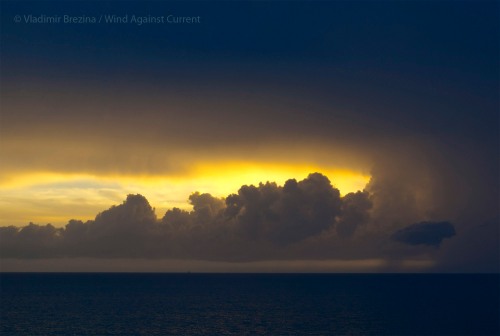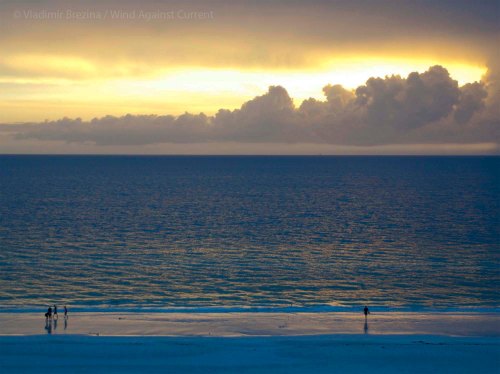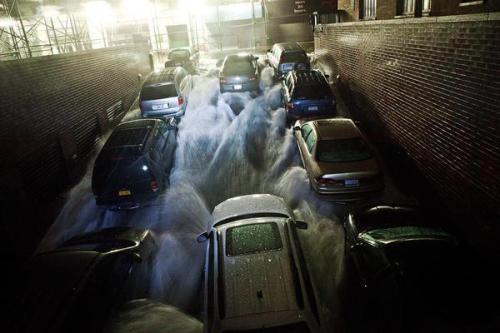By Johna Till Johnson and Vladimir Brezina

Wind forecast for 7pm Monday 10/29/12, from NOAA’s North American Mesoscale (NAM) model, showing winds blowing into NY Harbor at 45-50mph (red color) and even 50-55mph (magenta). The eye of the storm is the region with weak winds (white). Reproduced from SeaAndSkyNY.
Here’s your “feet-on-the-street” reporting from Hurricane/Nor’easter/Frankenstorm Sandy, from NYC. Please keep in mind that, as of this posting, we have no idea whatever what is going to happen—all we know is what the models forecast. Future posts will describe what actually did happen.
For an ongoing update, please check Philip Orton’s blog, SeaAndSkyNY. He’s an oceanographer and scientist whose data and insights we rely on regularly.
(For an amusing assessment of models and the people who create them, we recommend this xkcd cartoon. Be sure to mouse over the cartoon and read the comment that pops up.)
Friday 10/26/12, noon-ish. We decide to cancel our planned weekend camping trip up the Hudson, on the grounds that if Amtrak shuts down, we’ll be stranded. Little do we know we are going to miss out on the excitement of finding a body near our planned campground…
Saturday 10/27/12, morning. “We should get some supplies,” Vlad says. Since this is more or less what Johna has been thinking since we’d cancelled the camping trip, we are pretty much in alignment. (Vlad’s comment takes a generalized anxiety and makes it immediately actionable.)
So we run out and lay in supplies: salami, cheese, nuts, crunchy veggies, anything tasty and filling that doesn’t require cooking (in case of a power outage.) Plus food that can be cooked, in case the power is functional but the rest of NY infrastructure is not: sausages, meat.
Saturday 10/27/12, afternoon. Gowanus Canal paddle. We’re out for four-and-a-half hours in New York Harbor, mostly poking around. (Photos are here.) The salient elements—from the standpoint of an incoming hurricane—have to do with changes in the weather. When we set out it is overcast and warm—warm enough that Johna is overheating in her brand-new wetsuit and wetshirt. By the end of the afternoon, the wind has picked up and changed direction—instead of coming from the south/southwest, it is coming from the east. And we are happy to be wearing the wetsuits.
The most exotic part, though, is the sundog. If you’ve never seen one before (Johna hadn’t), they’re awesome. Looks like a brilliant double-rainbow in the sky—until you notice the two rainbows are symmetrical and curved facing each other, on either side of the sun. The sundog guides our travel most of the way home.
Sunday, 1o/28/12, noon-ish. New York City announces the shutdown of subways and buses. Amtrak closes lines, thus validating our decision not to go camping.
We rejigger plans (both professional and personal) to handle contingencies. The sky is slate-gray, but no wind or rain.
Sunday 10/28/12, afternoon. We are out and about. The wind has picked up, it’s definitely colder, and there’s a tang in the air that smells like snow to come—slightly odd since the temperature feels like the high 50s.
Sunday 10/28/12, 4:40 PM. The wind picks up even more, sending dry leaves dancing. A feathery smattering of rain sprays down, but nothing lasting. If you didn’t know better, you’d think this was an ordinary late-October day: cool, overcast, breezy, drizzly.
Sunday 10/28/12, 5:00 PM. The first serious gust kicks in. It’s still no more than 20-30 mph (hard to gauge on land) but something about it feels serious. Then it dies down.
Sunday 10/28/12, 5:30 PM. The local Duane Reade is sold out of bottled water. Also canned goods. But not, fortunately, of staples like olives and ice (for martinis).
Sunday 10/28/12, 9:15 PM. Stepping out of the neighborhood restaurant where we’ve had dinner, we’re greeted with a sustained blast of wind. Still no rain, though. Halloween decorations rattle (we wonder how well they’ll survive the next few days).
More to come…
Part 2 —>


























